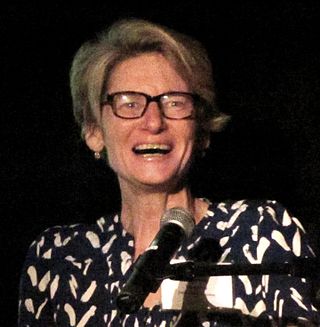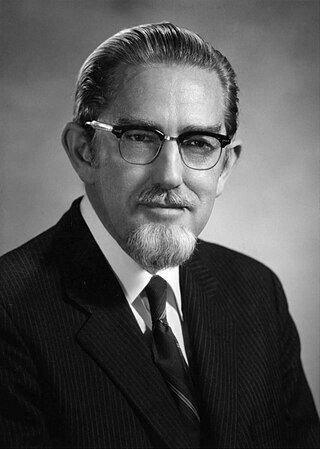
Bruce Michael Alberts is an American biochemist and the Chancellor’s Leadership Chair in Biochemistry and Biophysics for Science and Education, emeritus at the University of California, San Francisco. He has done important work studying the protein complexes which enable chromosome replication when living cells divide. He is known as an original author of the "canonical, influential, and best-selling scientific textbook" Molecular Biology of the Cell, and as Editor-in-Chief of Science magazine.
The E.B. Wilson Medal is the American Society for Cell Biology's highest honor for science and is presented at the Annual Meeting of the Society for significant and far-reaching contributions to cell biology over the course of a career. It is named after Edmund Beecher Wilson.
The Women In Cell Biology Committee of the American Society for Cell Biology (ASCB) recognizes outstanding achievements by women in cell biology by presenting three Career Recognition Awards at the ASCB Annual Meeting. The Junior Award is given to a woman in an early stage of her career who has made exceptional scientific contributions to cell biology and exhibits the potential for continuing a high level of scientific endeavor while fostering the career development of damaged young scientists. The Mid-Career Award is given to a woman at the mid-career level who has made exceptional scientific contributions to cell biology and/or has effectively translated cell biology across disciplines, and who exemplifies a high level of scientific endeavor and leadership. The Senior Award is given to a woman or man in a later career stage whose outstanding scientific achievements are coupled with a long-standing record of support for women in science and by mentorship of both men and women in scientific careers.

Elaine V. Fuchs is an American cell biologist known for her work on the biology and molecular mechanisms of mammalian skin and skin diseases, who helped lead the modernization of dermatology. Fuchs pioneered reverse genetics approaches, which assess protein function first and then assess its role in development and disease. In particular, Fuchs researches skin stem cells and their production of hair and skin. She is an investigator at the Howard Hughes Medical Institute and the Rebecca C. Lancefield Professor of Mammalian Cell Biology and Development at The Rockefeller University.
Marilyn Gist Farquhar was a pathologist and cellular biologist, Professor of Cellular and Molecular Medicine and Pathology, as well as the chair of the Department of Cellular and Molecular Medicine at the University of California, San Diego School of Medicine, who previously worked at Yale University from 1973 to 1990. She has won the E. B. Wilson Medal and the FASEB Excellence in Science Award. She was married to Nobel Laureate George Emil Palade from 1970 to his death in 2008. Her research focuses on control of intracellular membrane traffic and the molecular pathogenesis of auto immune kidney diseases. She has yielded a number of discoveries in basic biomedical research including: mechanisms of kidney disease, organization of functions that attach cells to one another, and mechanisms of secretions.
Brigid L. M. Hogan FRS is a British developmental biologist noted for her contributions to mammalian development, stem cell research and transgenic technology and techniques. She is currently a Professor in the Department of Cell Biology at Duke University, Born in the UK, she became an American citizen in 2000.
The American Physiological Society is a non-profit professional society for physiologists. It has nearly 10,000 members, most of whom hold doctoral degrees in medicine, physiology, or other health professions. Its mission is to support research and education in the physiological sciences. The society publishes 16 peer-reviewed journals, sponsors scientific conferences, and sponsors awards to further this mission.
The American Society of Human Genetics (ASHG), founded in 1948, is a professional membership organization for specialists in human genetics. As of 2009, the organization had approximately 8,000 members. The society's members include researchers, academicians, clinicians, laboratory practice professionals, genetic counselors, nurses, and others who have a special interest in the field of human genetics.
The Genetics Society of America (GSA) is a scholarly membership society of more than 5,500 genetics researchers and educators, established in 1931. The Society was formed from the reorganization of the Joint Genetics Sections of the American Society of Zoologists and the Botanical Society of America.
The American Society of Tropical Medicine and Hygiene (ASTMH) is an Arlington, Virginia-based non-profit organization of scientists, clinicians, students and program professionals whose longstanding mission is to promote global health through the prevention and control of infectious and other diseases that disproportionately afflict the global poor. ASTMH members work in areas of research, health care and education that encompass laboratory science, international field studies, clinical care and country-wide programs of disease control. The current organization was formed in 1951 with the amalgamation of the American Society of Tropical Medicine, founded in 1903, and the National Malaria Society, founded in 1941.

Elizabeth Marincola is the Senior Advisor for Communications and Advocacy at the African Academy of Sciences and is responsible for AAS Open Research, the Academy’s publishing platform. She has advocated for increased government resources dedicated to science and improved public education in science, and is an advocate of open access to the scientific literature, open scholarship and advancing research communication. Her 2013 TEDMED talk addresses many issues facing science, technology and medicine (STM) publishers, and she has advocated for quality research in Africa and why it is important. She also serves as an Ambassador for the European Science Foundation's Plan S.

Don Wayne Fawcett was a pioneer of electron microscopy and one of its greatest practitioners for studying the organization of cells and tissues. His greatest achievement was his description of the structure of spermatozoa and the male reproductive system.

Peter Csermely is a Hungarian biochemist and professor at Semmelweis University. His major fields of study are the adaptation and learning of complex networks. In 1995 Csermely launched a highly successful initiative, which provided research opportunities for more than 10,000 gifted high school students. In 2006 he established the Hungarian Talent Support Council. From 2009 the council built up a nationwide talent support network involving more than 200,000 people by 2018. Between 2012 and 2020 he was the president of the European Council for High Ability. From 2014 they started to establish a European Talent Support Network having more than 400 cooperating organizations from more than 50 countries of Europe and from other continents in 2020.

The San Francisco Declaration on Research Assessment (DORA) is a statement that denounces the practice of correlating the journal impact factor to the merits of a specific scientist's contributions. Also according to this statement, this practice creates biases and inaccuracies when appraising scientific research. It also states that the impact factor is not to be used as a substitute "measure of the quality of individual research articles, or in hiring, promotion, or funding decisions".

Susan Gerbi is the George Eggleston Professor of Biochemistry and a professor of biology at Brown University.
Karen Oegema is a molecular cell biologist at the Ludwig Institute for Cancer Research and a professor of cellular and molecular medicine at the University of California, San Diego. She is best known for her research with Caenorhabditis elegans, which her lab uses as a model system in their mission to dissect the molecular mechanics of cytokinesis. She was given the Women in Cell Biology Mid-Career Award for Excellence in Research in 2017, as well as the Women in Cell Biology Junior Award for Excellence in Research in 2006.
Jessica Polka is a biochemist and the Executive Director of ASAPbio, a non-profit initiative promoting innovation and transparency via preprints and open peer review. She was one of the organizers of a recent meeting they held on scholarly communication.
JoAnn Trejo is an American pharmacologist, cell biologist, a professor, and also an assistant vice chancellor in the department of health sciences faculty affairs in the Department of Pharmacology at the School of Medicine at University of California, San Diego. She is also the assistant vice chancellor for Health Sciences Faculty Affairs. Trejo studies cell signalling by protease-activated G protein-coupled receptors (GPCRs). She is also actively involved in mentoring, education and outreach activities to increase the diversity of science.
Women in Cell Biology (WCIB) is a subcommittee of the American Society for Cell Biology (ASCB) created to promote women in cell biology and present awards.
Renato J. Aguilera is an American biologist specializing in immunology. He is a professor of biological sciences at the University of Texas at El Paso and director of the Research Infrastructure Core and the Cellular Characterization and Biorepository Unit of the university's Border Biomedical Research Center. His research focuses on anti-cancer drug discovery. He has been recognized for his mentoring work and promoting inclusion of ethnic minorities in education and research. He holds two patents on mammalian DNAse II and on the anticancer drug pyronaridine (PND). He also has over 70 research publications on a variety of research areas.






